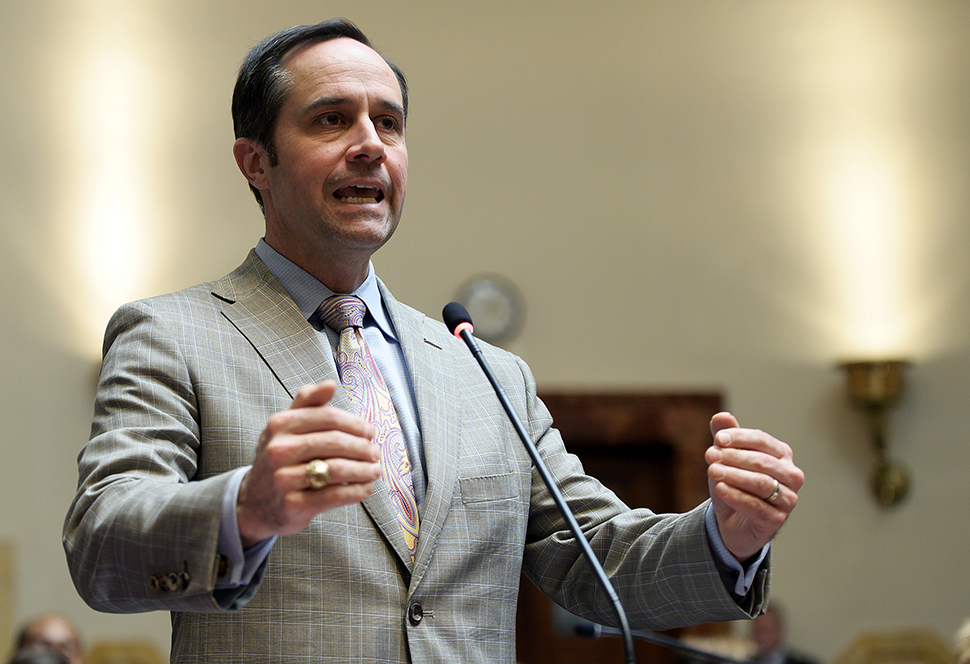House, Senate release budgets: What to know
Published 2:33 pm Wednesday, March 20, 2024

- FRANKFORT, Feb. 21 – Sen. Christian McDaniel, R-Ryland Heights, speaks about Senate Bill 126, legislation that proposes to amend sections of the state constitution related to gubernatorial pardons. McDaniel spoke on the Senate floor Wednesday. (Legislative Research Commission)
With eight legislative days left this year, the General Assembly is working to finalize the next two-year budget.
The House and Senate have passed separate versions of the budget and now must come to an agreement on a final document in a conference committee.
If they cannot agree there, the budget will go to a free conference committee, where negotiations may be more open. This is the most probable outcome.
Currently, the House budget includes $1.8 billion in one-time spending through the Budget Reserve Trust Fund, commonly referred to as the rainy day fund.
The Senate budget nearly doubles that amount, spending $3.5 billion of the Commonwealth’s current surplus on one-time projects.
There are also differences in the executive branch budget, which includes the funds the government and its various agencies and departments need to operate on a daily basis.
The House appropriated $131.4 billion to cover the biennium, while the Senate appropriated $129.8 billion. Both chambers used about $32 billion in state general funds in the executive branch budget.
Budgets run hundreds of pages long, but there are several key investments to know.
Education
Gov. Andy Beshear has been fighting for— and campaigning on—11% raises for school staff for almost a year. However, the current budget versions do not include them.
Both budget versions raise base SEEK funding, which appropriates a certain amount of money to each school district based largely on average attendance numbers.
However, superintendents across the Commonwealth have said that the increase would only allow for a one or two percent salary increase, which does not keep up with inflation.
At the same time, the House budget warned districts that if they did not make “adequate progress in the recruitment and retention of classroom teachers and classified employees” they may face school closure, state takeover of education boards or potential consolidation.
The Senate removed this language. It also made an addition to part of the SEEK formula—the Tier 1 component. This component requires local districts to levy a tax of at least 30 cents per $100 of assessed property value as their contribution to the SEEK fund.
Currently, if local districts levy a higher tax than required, the state matches their contribution up to 15%. The Senate budget raises that to 20%.
Sen. Christian McDaniel, R-Ryland Heights, said the Senate chose to fund Tier 1 instead of fully funding student transportation costs. While the House funds student transportation at 80% the first year and 100% the second, the Senate lowers the second year to 90%.
McDaniel said not all district have urgent transportation costs, so Tier 1 was a better investment.
School districts currently cannot raise tax rates that would produce tax revenue over four percent higher than the previous year. The Senate budget would also allow growth districts to forgo that limitation.
Beshear was not satisfied with the state of the education budget proposals, which do not include universal pre-K or teacher student loan forgiveness either.
“To have a strong system of public education, we’ve got to pay our teachers, our bus drivers, our custodians, our mental health counselors closer to what they’re worth,” Beshear said at his weekly presser.
One time spending
The Senate kept all of the House’s one-time spending, but added much more.
One major item is a “13th check” for retirees in the Kentucky Employees Retirement System or State Police Retirement System. Beshear asked for this in his proposed budget in lieu of a full cost of living adjustment increase.
The one-time payments are tiered based on recipients’ current retirement allowances, and the total cost would be $74.7 million.
Other budget line items include $75 million for nuclear energy research at the University of Kentucky, $100 million for various downtown Louisville projects, several airport improvements, university cybersecurity programs and $10 million for a Lexington affordable housing program.
Neither budget includes additional funding for the statewide Affordable Housing Trust Fund or the Rural Housing Trust Fund.
“We felt like investing in Lexington was appropriate, but we’re also concerned that the supply of the construction trades right now is pretty stretched thin anyway and we’re very worried about inflating already inflated costs,” McDaniel said.
Other items
Juror pay
Kentucky’s juror pay has sat at $5 per day, with up to $7.50 in reimbursed expenses, for decades. There are several bills working their way through the legislature attempting to raise this pay, but the Senate budget bypasses all of that.
Its budget includes $25 per day, plus $7.50 for expense reimbursement, which will cost $5 million a year.
Law enforcement funds
Both budgets increase appropriations to the Kentucky Law Enforcement Foundation Program Fund.
The House adds $212.4 million to KLEFP—a 4% training stipend increase the first year and a 2% increase the second—while the Senate adds $196.5 million, a 2.6% increase each year.
During a conference committee meeting, the Senate agreed with the House’s inclusion of a Kentucky State Police recruitment and retention report.
The report would track gender, race, education level and geography for trooper cadet classes from 2023 to 2026 to refine recruitment and ensure all areas of the Commonwealth are represented.
Juvenile justice
There’s been a lot of talk surrounding the juvenile justice crisis in Kentucky. The Senate budget puts the state’s money where its mouth is, appropriating $45 million each to build female detention centers in Fayette County and Western Kentucky.
The Senate also appropriated $5 million for the design of a high-acuity juvenile mental health treatment facility.
Healthcare
In the child care realm, both budgets keep the Child Care Provider Reimbursement Rate at 80% of the market rate.
They maintain the program allowing child care staff to have their own child care paid for, but do not add funding to make up for the looming expiration of federal child care funding.
Advocates are concerned that leaving child care funding out will cause a child care cliff that may close already limited childcare centers, raise tuition or further depress childcare workers’ wages.
Beshear said he was pleased that the Senate budget restored Medicaid funding the House removed. However, Senate also added language that required all individuals on waiting lists for Medicaid waiver slots be assessed before any funds can be released.
“We have people who appear on multiple lists, we have people who have aged out of lists, people who have progressed to other services,” McDaniel said. “And we never really have track of what has been done there.”
The income tax
Throughout the budget process, one thing has been on the back of legislators’ minds—the income tax rate.
In order to further lower the income tax, the General Assembly has to meet certain “triggers,” or thresholds to ensure the state has enough money to afford it.
McDaniel said the Senate took out about $390 million in the budget’s second year “specifically for the idea that we would be able to hit the trigger to lower to 3.5% at the beginning of ’26.”





